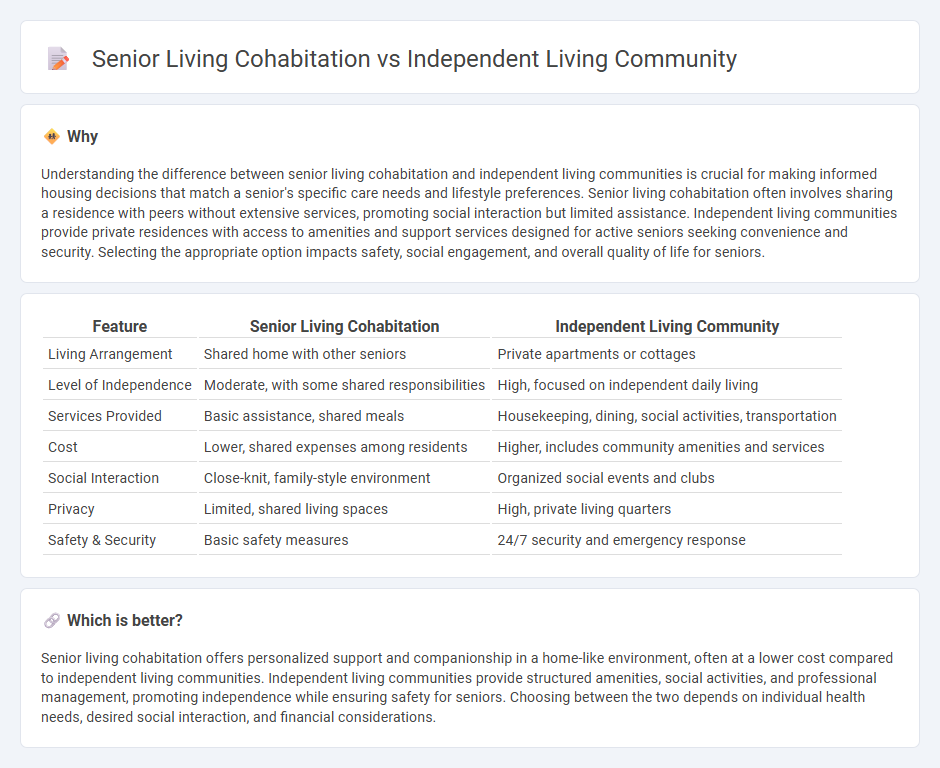
Senior living cohabitation offers shared living spaces and collaborative community engagement, promoting social interaction and mutual support among residents. Independent living communities focus on privacy and self-sufficiency, providing amenities and services that cater to seniors seeking autonomy while minimizing daily responsibilities. Explore the benefits and lifestyle differences of each option to determine which best suits your needs in senior real estate.
Why it is important
Understanding the difference between senior living cohabitation and independent living communities is crucial for making informed housing decisions that match a senior's specific care needs and lifestyle preferences. Senior living cohabitation often involves sharing a residence with peers without extensive services, promoting social interaction but limited assistance. Independent living communities provide private residences with access to amenities and support services designed for active seniors seeking convenience and security. Selecting the appropriate option impacts safety, social engagement, and overall quality of life for seniors.
Comparison Table
| Feature | Senior Living Cohabitation | Independent Living Community |
|---|---|---|
| Living Arrangement | Shared home with other seniors | Private apartments or cottages |
| Level of Independence | Moderate, with some shared responsibilities | High, focused on independent daily living |
| Services Provided | Basic assistance, shared meals | Housekeeping, dining, social activities, transportation |
| Cost | Lower, shared expenses among residents | Higher, includes community amenities and services |
| Social Interaction | Close-knit, family-style environment | Organized social events and clubs |
| Privacy | Limited, shared living spaces | High, private living quarters |
| Safety & Security | Basic safety measures | 24/7 security and emergency response |
Which is better?
Senior living cohabitation offers personalized support and companionship in a home-like environment, often at a lower cost compared to independent living communities. Independent living communities provide structured amenities, social activities, and professional management, promoting independence while ensuring safety for seniors. Choosing between the two depends on individual health needs, desired social interaction, and financial considerations.
Connection
Senior living cohabitation and independent living communities intersect by providing tailored housing options that cater to the evolving needs of older adults. Both models emphasize autonomy, social engagement, and accessibility, creating environments that promote quality of life while minimizing the challenges of aging in place. Real estate developments focused on these sectors demonstrate growing demand for age-friendly design, wellness amenities, and community-oriented living spaces.
Key Terms
Autonomy
Independent living communities prioritize autonomy by offering seniors private residences with tailored services that support self-sufficiency, such as meal plans and housekeeping without medical care. Senior living cohabitation often involves shared living arrangements where autonomy varies based on communal rules and shared responsibilities, potentially limiting individual private space. Explore more about how these living options impact seniors' independence and quality of life.
Shared amenities
Independent living communities offer private residences with access to shared amenities such as fitness centers, dining options, and social activity rooms designed to promote an active lifestyle among seniors. Senior living cohabitation emphasizes communal living spaces where residents share kitchens, lounges, and household responsibilities to foster close-knit social connections. Explore more about how shared amenities impact lifestyle choices in senior housing.
Community engagement
Independent living communities foster active community engagement through organized social activities, shared amenities, and wellness programs tailored for seniors seeking autonomy with social interaction. Senior living cohabitation emphasizes close-knit, informal connections among residents, promoting mutual support and companionship in a smaller, home-like environment. Explore the benefits of each living arrangement to find the ideal community engagement experience for your lifestyle.
Source and External Links
Independent Living for Seniors - Independent living communities are designed for healthy, active seniors who manage daily tasks without assistance, offering amenities like housekeeping and social activities.
Independent Senior Living - Independent senior living communities provide housing for seniors 55 and older, offering services like dining and transportation without assistance with daily activities.
How to Select an Independent Living Community - This guide helps choose independent living communities that offer services like fitness classes and social activities, tailored to seniors' needs.
 dowidth.com
dowidth.com